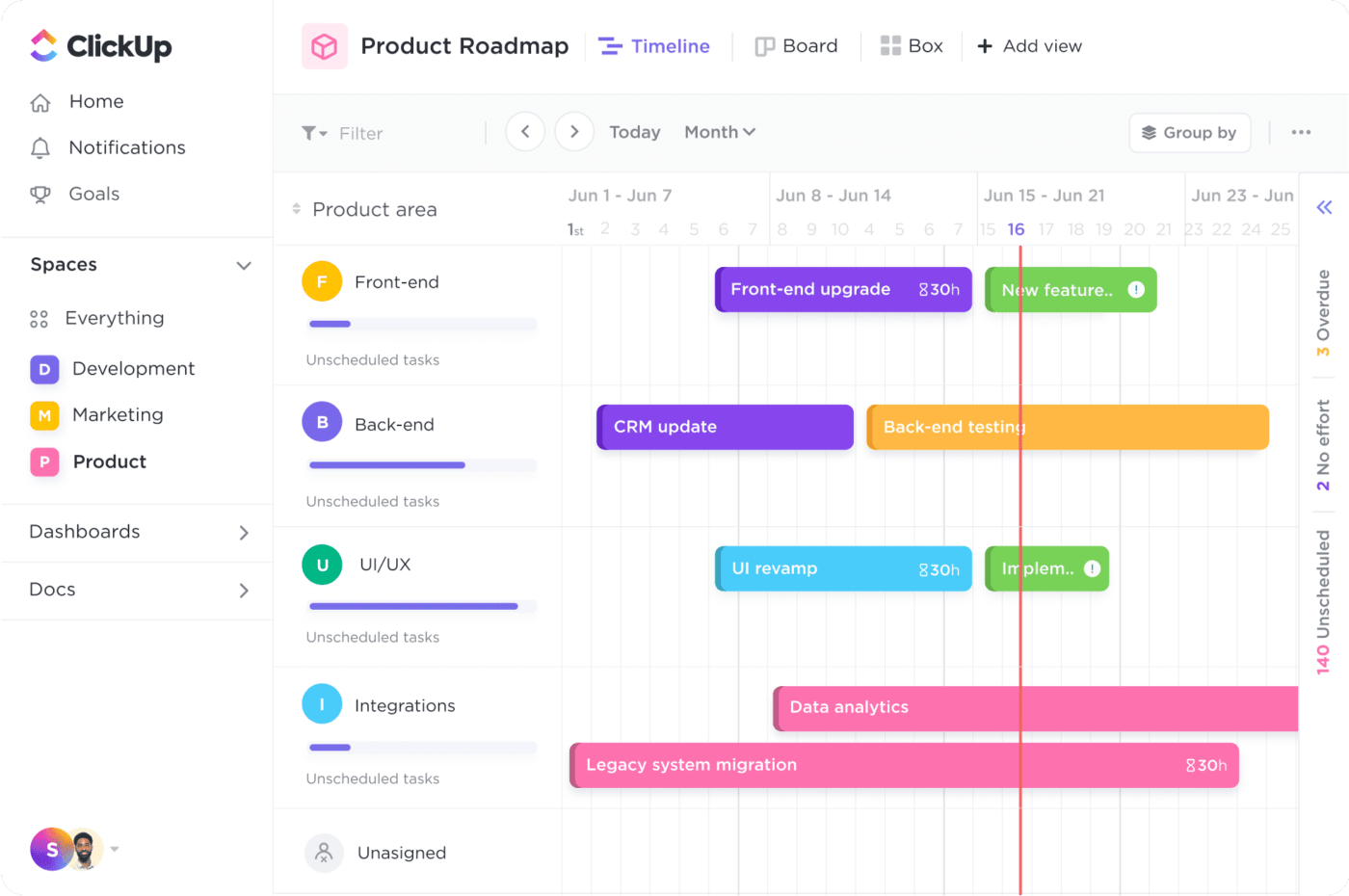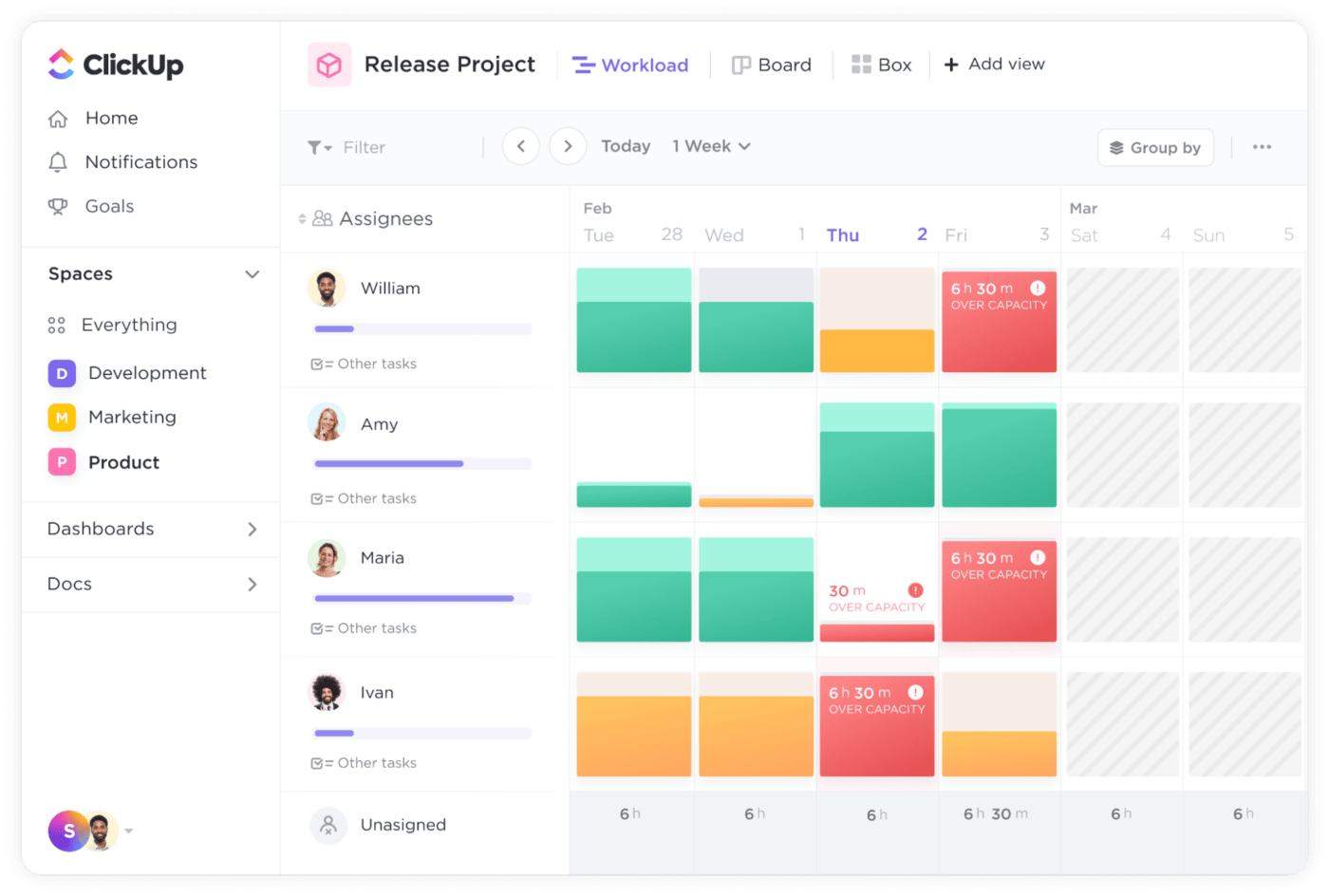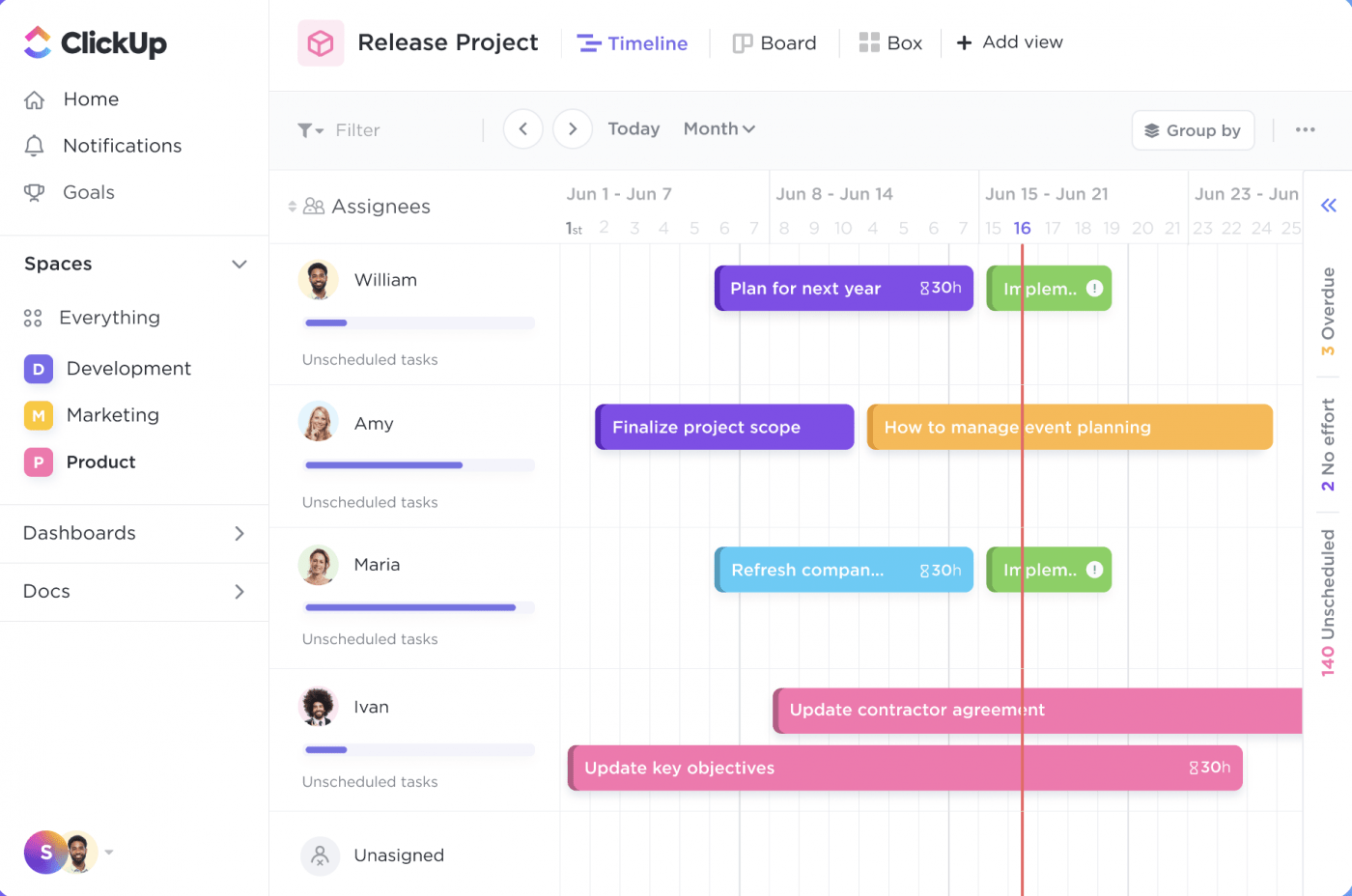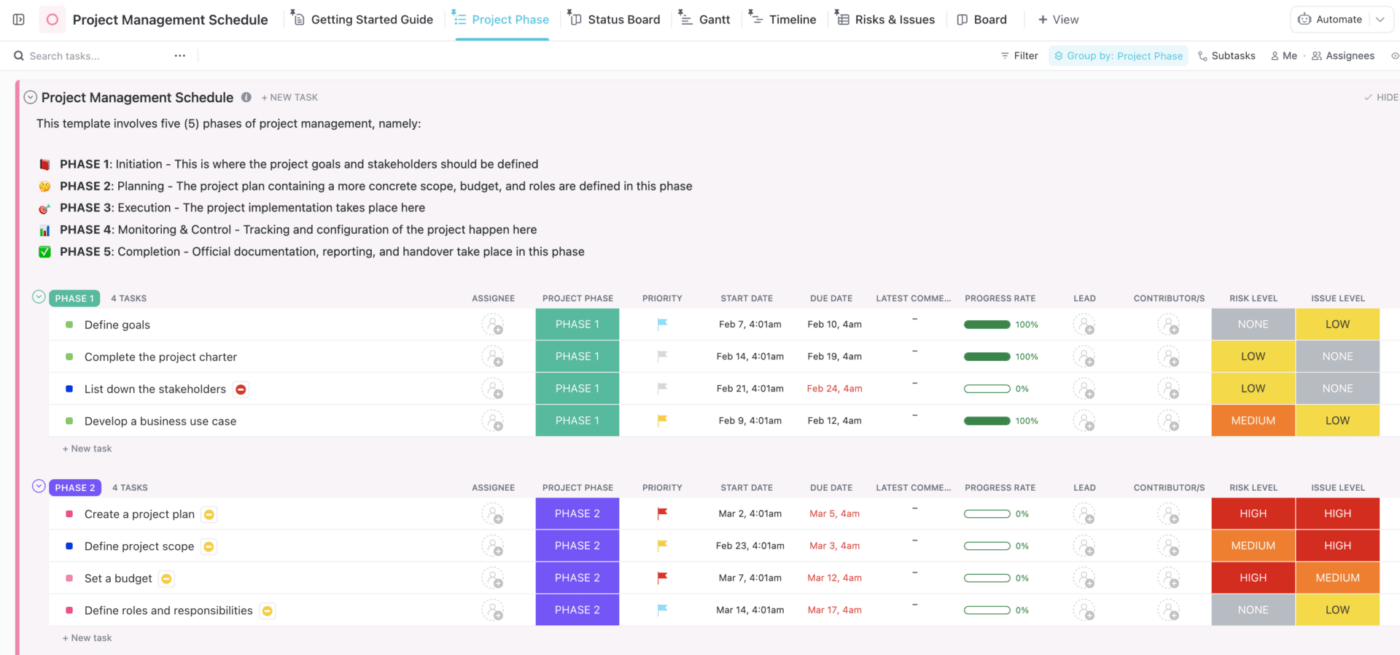- 1. Set the scope of the project
- 2. Define project tasks and responsibilities
- 3. Set a task sequence
- 4. Decide what resources you need
- 5. Set a timeline for tasks
- 6. Develop the final project schedule
Summarize this article with AI ClickUp Brain not only saves you precious time by instantly summarizing articles, it also leverages AI to connect your tasks, docs, people, and more, streamlining your workflow like never before. Summarize article
Summarize this article for me pleaseWhat is a Project Schedule?
A project schedule is a simplified road map of activities, resources, and due dates that help your team meet a final goal. It breaks down the who, what, when, and how of your project. The process involves gathering background information, including which team members will be responsible for what tasks, and establishing deadlines that should be met. Once created, the project schedule acts as a timeline and go-to resource for all team members. Everyone involved in the project plan should be able to see where each task stands, its start and end dates, and whether the project status is meeting the established deadline. ⏳

It sounds like a lot. But project scheduling is a critical aspect for project managers and their role. It requires excellent time management skills and a high level of organization to know critical aspects of the project life cycle and the overall task dependencies in each phase. But you don’t have to do it all on your own. There are project schedule templates and software tools that can help you get the job done in less time. Read on to learn more about the benefits of a project schedule and tips on how to create one using templates from ClickUp.
Summarize this article with AI ClickUp Brain not only saves you precious time by instantly summarizing articles, it also leverages AI to connect your tasks, docs, people, and more, streamlining your workflow like never before. Summarize article
Summarize this article for me pleaseBenefits of an Effective Project Schedule
- Makes tracking, reporting, and sharing project progress with all team members easier
- Establishes clear expectations for tasks, responsibilities, start and end dates, and deadlines
- Identifies potential bottlenecks, such as lack of bandwidth for certain team members or difficulty with resource allocation
- Lets you see issues as soon as they arise with real-time project monitoring, so you can address them before they affect deliverables
- Encourages employee accountability. Each team member knows exactly what’s expected of them and is aware of the deadlines they affect in the project scheduling process
- Supports better financial performance by clearly laying out necessary resources and keeping a lid on unexpected expenses
- Ensures better quality since team members outline the project from start to finish and are able to schedule testing and avoid last-minute changes—helping project managers at the same time
- Identifies task dependencies and relationships so you can easily see which tasks are dependent on other tasks getting done first. This makes it easy to identify any potential roadblocks and areas where the entire project may be delayed
Summarize this article with AI ClickUp Brain not only saves you precious time by instantly summarizing articles, it also leverages AI to connect your tasks, docs, people, and more, streamlining your workflow like never before. Summarize article
Summarize this article for me pleaseHow to Create a Project Schedule for Your Team
Ready to create a project schedule for your team? We’re here to help with this step-by-step guide. 🌻
1. Set the scope of the project
The first thing you need to do is figure out the scope of the entire project. Who are the main stakeholders and team members that will be involved? What will they be responsible for? When would you like the whole project to be completed? Answer these questions to establish the project scope. Once you have that laid out, outline the policies, procedures, and deliverables for the project. Are there procedures established by higher-ups or the department that need to be followed? Will you need to secure resources from outside organizations? How do you define project success? Think about these types of things when outlining procedures that need to be followed during the project. Need help with this project planning step? Use ClickUp’s Project Scope Whiteboard Template where you can sketch out a summary of activities and resources needed as well as estimate due dates and deliverables.
2. Define project tasks and responsibilities

Now that you know what the project entails, it’s time to start defining tasks and responsibilities. Consider all team members that will play a role in the project. Decide which project activities and tasks they’ll need to handle. You can pair this with a work breakdown structure (WBS)—like the Work Breakdown Whiteboard Template from ClickUp—which outlines all specific tasks and subtasks that are required for each person to complete their portion of the project. This is also the time when you’ll establish any project milestones. ✅
3. Set a task sequence

Next, it’s time to evaluate task dependencies. That means going through your task list to figure out what sequence of events needs to happen to meet your project goals. Does one of your predefined tasks need to be fully completed before another one can begin? If yes, you’ll want to make sure you prioritize your schedule and effort toward those tasks first. Can other tasks overlap or be worked on at the same time? Great! You’ll want to plan on scheduling those simultaneously to cut down on the project time. Did you know you can use ClickUp to set your task dependencies? Use the software tool to identify any tasks that are waiting on others for completion, tasks that are being blocked, and tasks that are unhindered.
4. Decide what resources you need

Resource management is a huge part of any successful project. When you have the right resources when you need them, you can move at the speed of light. When you don’t, the project starts to fall apart, causing delay after delay. Support your project teams by identifying what resources you need to bring the project to completion. This includes considering labor, finances, material resources, and assets. ClickUp’s Workload View lets you see who’s behind, who’s ahead, and who’s on track. That way you can adjust your project schedule to make up for any shortfalls. With ClickUp’s Dashboards, you can create Gantt charts and Kanban boards to quickly visualize resources and project standings.
5. Set a timeline for tasks

No project schedule is complete without a timeline. Start by estimating the project timeline and how long it’ll take to complete each task. Build out your project calendar from there by adding start and end dates for subtasks and milestones. Use project timeline templates in ClickUp, Excel, and other tools to create a project calendar and track project progress. 🗓️ If you have a Business Plan with ClickUp, you can use a Timeline View to get a linear visual of the project tasks and timeline. Customize the view to show the information that’s most relevant to you or select the “group by” filter to see the timeline for individual employees or priority tags. Try out these construction scheduling tools!
6. Develop the final project schedule
It’s finally time to complete your project schedule! Create an official start date and end date for the project baseline. There are several different techniques and methods of creating the actual project schedule. These include the critical path method (CPM), which focuses on the longest possible timeline to achieve your desired goal given the predefined tasks. It’s a good choice for project managers that want to be able to quickly see what tasks can delay the project and identify any potential roadblocks. Another alternative is the program evaluation and review technique. This methodology is a network diagram of nodes and arrows that highlight dependent tasks and milestones. With this overview, you can plan out the project and streamline workflows while keeping the start and finish dates in mind.

Create your project schedule today using ClickUp’s Project Schedule Template. Four custom fields in this project management tool let you quickly see the budget, team members, timeline, and project stages. Use the four different views to toggle between a project timeline overview and an in-depth look at the various project phases. ✍️
Summarize this article with AI ClickUp Brain not only saves you precious time by instantly summarizing articles, it also leverages AI to connect your tasks, docs, people, and more, streamlining your workflow like never before. Summarize article